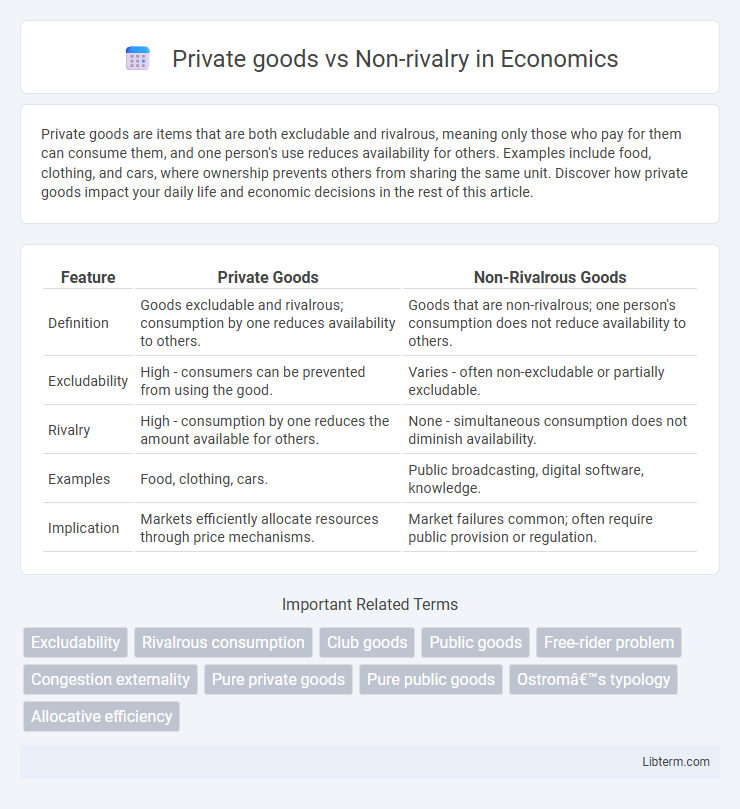Private goods are items that are both excludable and rivalrous, meaning only those who pay for them can consume them, and one person's use reduces availability for others. Examples include food, clothing, and cars, where ownership prevents others from sharing the same unit. Discover how private goods impact your daily life and economic decisions in the rest of this article.
Table of Comparison
| Feature | Private Goods | Non-Rivalrous Goods |
|---|---|---|
| Definition | Goods excludable and rivalrous; consumption by one reduces availability to others. | Goods that are non-rivalrous; one person's consumption does not reduce availability to others. |
| Excludability | High - consumers can be prevented from using the good. | Varies - often non-excludable or partially excludable. |
| Rivalry | High - consumption by one reduces the amount available for others. | None - simultaneous consumption does not diminish availability. |
| Examples | Food, clothing, cars. | Public broadcasting, digital software, knowledge. |
| Implication | Markets efficiently allocate resources through price mechanisms. | Market failures common; often require public provision or regulation. |
Introduction to Private Goods and Non-Rivalry
Private goods are characterized by excludability and rivalry, meaning consumption by one individual reduces availability for others. Non-rivalry refers to goods where one person's use does not diminish another's ability to consume the same good, often seen in public goods like digital content or street lighting. Understanding the distinction between private goods and non-rivalrous goods is crucial for economic allocation and policy design.
Defining Private Goods: Key Characteristics
Private goods are defined by their excludability and rivalry in consumption, meaning one person's use directly reduces availability for others and access can be restricted. These goods, such as food, clothing, and cars, are individually owned and consumed, preventing simultaneous use without depletion. The key characteristic of rivalry distinguishes private goods from non-rivalrous goods like public parks or broadcast signals, where one individual's consumption does not diminish availability for others.
Understanding the Concept of Non-Rivalry
Non-rivalry is a key characteristic of non-private goods where one person's consumption does not diminish the availability for others, unlike private goods which are rivalrous and exclusive. Public goods like national defense and clean air exemplify non-rivalry, allowing simultaneous use by multiple individuals without depletion. Understanding non-rivalry helps in designing efficient resource allocation and policy-making to address market failures associated with public and common goods.
Private Goods vs Non-Rival Goods: Core Differences
Private goods are characterized by excludability and rivalry, meaning consumption by one individual reduces availability for others, exemplified by items like food and clothing. Non-rival goods, such as public broadcasts and digital content, allow simultaneous consumption by multiple users without diminishing the supply. This fundamental difference highlights how private goods require allocation mechanisms to manage scarcity, whereas non-rival goods promote widespread access without competition for usage.
Examples of Private Goods in Everyday Life
Private goods, characterized by excludability and rivalry, include items such as clothing, food, and automobiles, which are consumed exclusively by the purchaser and diminish in availability for others. A person buying a sandwich prevents others from eating the same sandwich, illustrating the rivalry aspect of private goods. Unlike public goods, these private goods require individual payment and consumption, making them prevalent examples in everyday economic transactions.
Illustrative Cases of Non-Rival Goods
Non-rival goods allow simultaneous consumption without diminishing availability, exemplified by digital products like streaming services and online courses where multiple users access content without reducing others' experience. Public broadcasting and open-source software also illustrate non-rivalry, as their usage by one individual does not limit accessibility for others. These cases contrast sharply with private goods, which face consumption exclusion and rivalry, such as food items and clothing.
Economic Implications of Private Goods
Private goods are characterized by rivalry and excludability, meaning consumption by one individual reduces availability for others and access can be restricted. This exclusivity incentivizes producers to allocate resources efficiently and innovate, driving competitive markets and optimal pricing mechanisms. However, the rivalry aspect can lead to market failures like under-provision or overconsumption without proper regulation or externality correction.
Social Benefits of Non-Rival Goods
Non-rival goods, such as public parks and open-source software, deliver significant social benefits by allowing multiple individuals to consume the good simultaneously without depletion. Unlike private goods, which possess exclusive consumption rights and diminish in availability as more people use them, non-rival goods enhance overall welfare by promoting equitable access and reducing marginal costs. This characteristic supports sustainable resource distribution and fosters community engagement, ultimately leading to positive externalities in society.
Challenges in Classifying Goods: Gray Areas
Classifying goods as private or non-rivalrous involves challenges due to gray areas where characteristics overlap, such as congestible public goods that exhibit non-rivalry up to a capacity threshold. Private goods typically involve exclusive consumption and rivalry, but certain goods demonstrate partial non-rivalry or exclusion issues complicating straightforward categorization. This ambiguity affects policy decisions, resource allocation, and economic modeling by blurring the lines between pure private and public goods.
Conclusion: Why the Distinction Matters
The distinction between private goods and non-rivalrous goods is crucial because it affects resource allocation and market efficiency. Private goods, characterized by excludability and rivalry, require pricing mechanisms to prevent overconsumption, whereas non-rivalrous goods, such as digital content and public infrastructure, allow simultaneous consumption without depletion. Understanding this difference informs policy decisions on funding, provision, and regulation to optimize social welfare and prevent market failures.
Private goods Infographic

 libterm.com
libterm.com